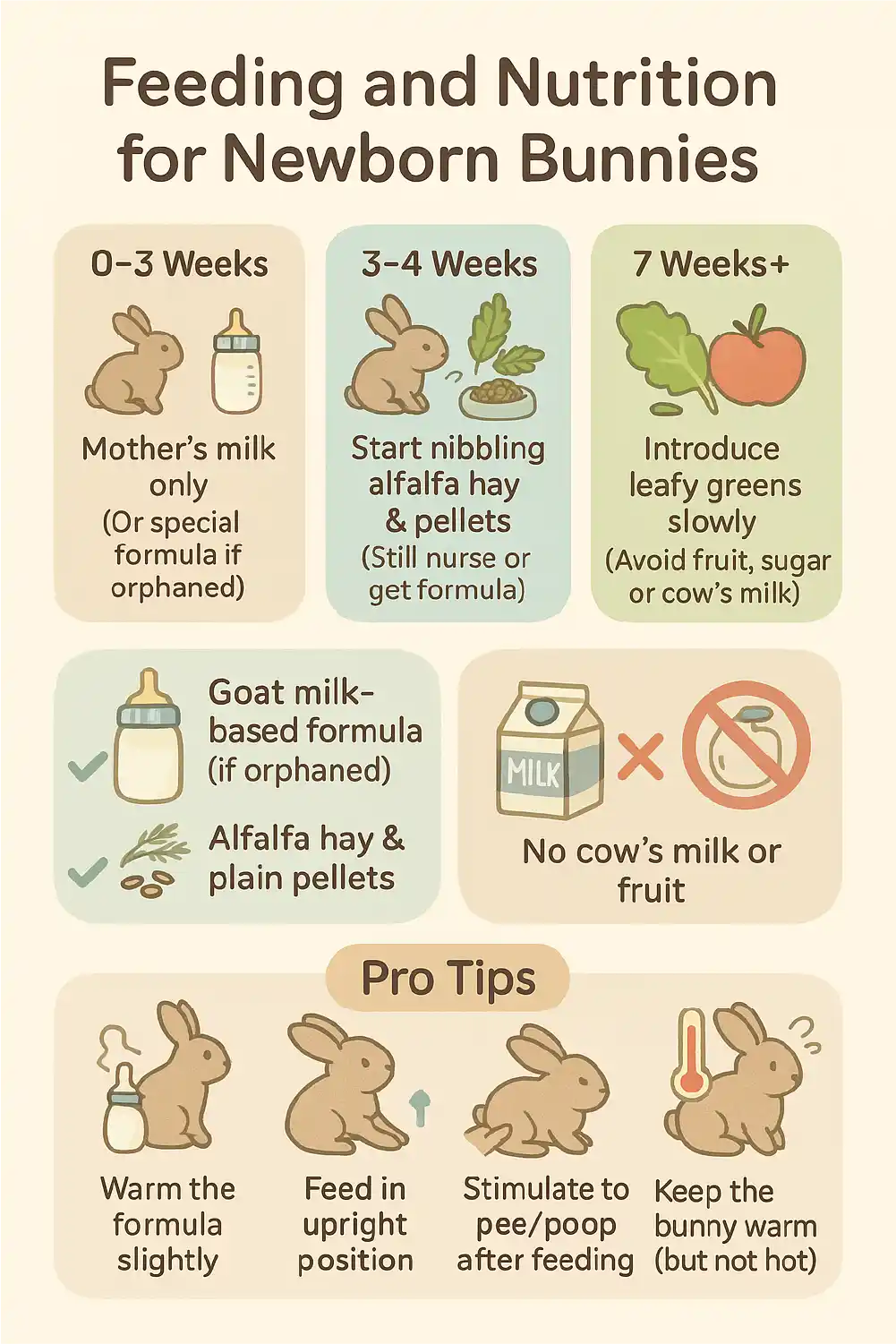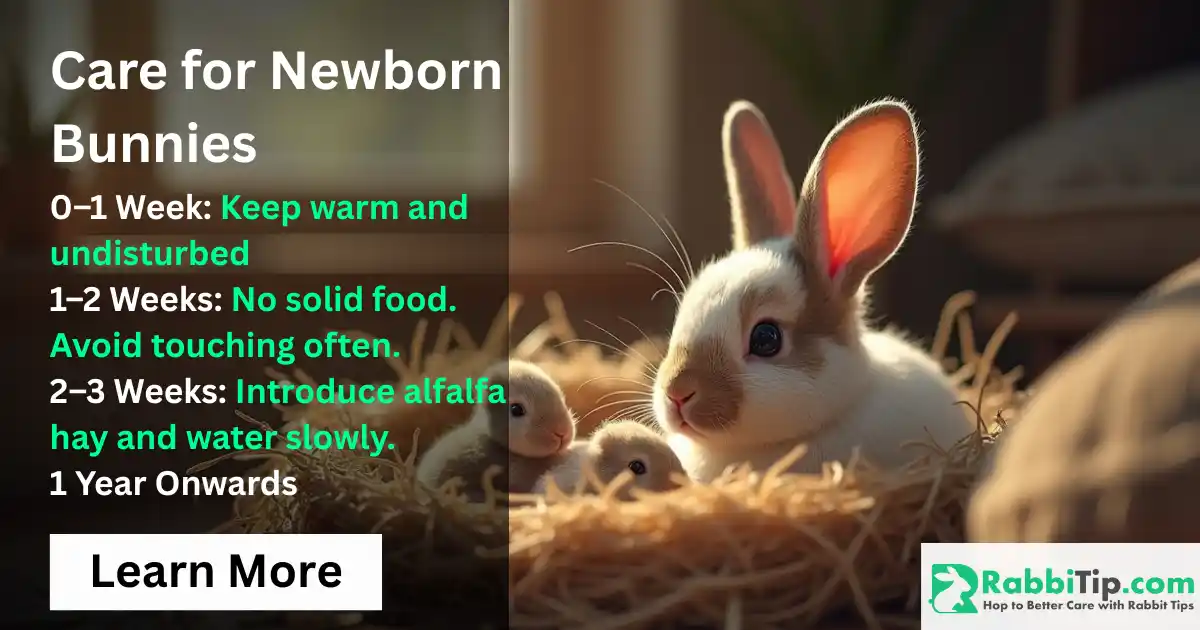How to take care for Newborn Bunnies
Having baby bunnies is exciting—but it’s also a delicate time. Whether you’re new to rabbits or have experience, caring for newborns bunnies takes quick action, gentle care, and the right knowledge to keep them healthy.
Newborn bunnies (called kits) are born blind, without fur, and fully dependent on their mother. The first few weeks are the most fragile. That’s why it’s important to know what to do right after birth.
Your job is to give them a safe, warm, and quiet place that feels like their natural home. This guide will show you:
- What to do in the first few hours
- Step-by-step care by age
- Feeding tips and schedules
- How to set up the right home
- When to handle and socialize
- Signs of health problems
- When to call a vet
What to do right after birth of Bunnies
The first hours after a rabbit gives birth are very important. Taking the right steps early can help keep both the mom (doe) and her babies safe and healthy.
Here’s what to do:
- Do Not Disturb Immediately:
Leave the mother and babies alone for the first 30–60 minutes after birth. The mother needs this time to finish delivering and clean the babies. - Inspect the Nest Gently:
After 1–2 hours, inspect the nest. Use clean hands or gloves. Check for:- Dead kits and remove them.
- Kits outside the nest box (place them back in carefully).
- Adequate fur lining (add hay if necessary for warmth).
- Count the Kits:
Take a quick headcount to monitor their growth later. Newborn bunnies are typically between 4–12 per litter. - Check Mother’s Condition:
Ensure she’s healthy:- Eating and drinking
- No signs of bleeding or distress
- Calm and resting
- Confirm Nursing:
Most mothers nurse once or twice a day. You may not see her do it, but check if:- Kits have round bellies
- They are warm and responsive
- Control the Temperature:
Nest area should be around 75–80°F (24–27°C). Use a heating pad under half the box if needed (never directly under kits). - Document Birth Date:
Record the date of birth for health checks, weaning, and vaccinations later. - Minimize Stress:
Keep the area quiet, limit handling, and keep away other pets.
Care tips for each Baby Bunny development stage
| Age | Care Requirements |
|---|---|
| 0–1 Week | Keep warm and undisturbed. No eyes or fur yet. Monitor feeding (round bellies = fed). |
| 1–2 Weeks | Eyes begin opening, fur grows. Still no solid food. Avoid touching often. |
| 2–3 Weeks | Begin exploring. Introduce alfalfa hay and water slowly. |
| 3–4 Weeks | Start solid food. Watch for diarrhea or dehydration. |
| 4–6 Weeks | Weaning begins. Provide pellets + hay. Reduce mom’s milk access gradually. |
| 6–8 Weeks | Fully weaned. Separate by sex if possible. Socialize daily. |
| 2–3 Months | Litter training can begin. Monitor behavior changes. |
| 3–6 Months | Increase diet variety. Spaying/neutering may be discussed with vet. |
| 6–12 Months | Adult food ratio (hay 80%, pellets 10%, veggies 10%). Regular play and social time. |
| 1 Year Onwards | Maintain healthy weight, check teeth and nails monthly, annual vet check recommended. |
Feeding and Nutrition for Newborn Bunnies
Feeding is a vital aspect of baby bunny care, especially if the mother is absent. Here’s how to ensure your kits are getting proper nutrition:
- Mother’s milk is best: Let the mother nurse naturally. She’ll feed once or twice daily for 3–5 minutes.
- No Cow’s milk: Never use cow’s milk. If orphaned, use Kitten Milk Replacer (KMR) or goat milk as substitute.
- Feeding schedule (if orphaned):
- Days 1–7: 2x daily, 1–2 ml
- Days 7–14: 2x daily, 2–4 ml
- Days 14–21: 2x daily, 4–5 ml
- After 21 Days: Introduce alfalfa hay and pellets
- Keep upright: Hold the bunny upright while feeding to prevent aspiration.
- Warm the milk: Slightly warm milk to room temperature before feeding.

Learn more about what do baby bunnies eat.
Creating a safe and comfortable home
Your bunnies’ environment impacts their growth and survival. A clean, quiet, and temperature-regulated space is essential.
- Use a Nesting Box: Line it with soft hay and fur plucked by the mother or substitute with cotton.
- Keep Indoors: For the first month, keep the box inside away from drafts and predators.
- Maintain Temperature: Use heating pads under half of the nest, never inside.
- Low Light & Quiet Area: Loud sounds and bright lights can stress both the mother and kits.
- Easy Access for Mom: Ensure mom can enter and exit easily but babies cannot wander out.
Monitoring health and growth for Newborn Bunnies
| Age | What to Monitor |
|---|---|
| 0–1 Week | Belly roundness, body warmth, responsiveness |
| 1–2 Weeks | Eye development, fur growth, movement |
| 2–3 Weeks | Weight gain, stool consistency, alertness |
| 3–4 Weeks | Eating hay, urination, weaning signs |
| 4–6 Weeks | Steady weight, playful behavior, healthy poop (golden pellets) |
| 6–8 Weeks | Interaction with siblings, eating habits |
| 2–3 Months | Clean ears/eyes, teeth growth, coat health |
| 3–6 Months | Normal molting, no aggression or lethargy |
| 6–12 Months | Proper litter use, grooming, appetite, dental alignment |
Preparing for the arrival of Newborn Rabbits
Before birth, prepare:
- A nesting box (12″x10″x10″)
- Clean soft hay
- Digital thermometer
- Heating pad (optional)
- Quiet, warm room
- Vet’s contact information
Daily health checks
Each morning, quickly check:
- Eyes for discharge
- Nose for dryness or crust
- Ears for mites
- Feet and belly for injury
- Behavior for alertness
Socialization and Bonding
Begin gentle interaction by the 3rd or 4th week. Sit near them quietly, speak softly, and offer small treats like parsley. Never rush bonding.
Safety from predators or pets
Keep nest away from cats, dogs, or outdoor predators. Use wire mesh lids on boxes. Indoors, restrict access to the rabbit’s room.
Litter box training
- Begin training at 6–8 weeks old.
- Use a low-sided litter box with paper-based litter.
- Place it in one corner of the enclosure.
- Observe where the bunny pees and move box there.
- Praise them or give a treat for using it correctly.
Feeding frequency & schedule
| Age | Frequency |
|---|---|
| 0–3 Weeks | Once or twice a day (by mother) |
| 3–6 Weeks | 3–4x pellets + unlimited hay |
| 2–3 Months | 2x pellets + hay + water |
| 3 Months + | 2x daily, fresh veggies added |
When to call a Vet
Call a rabbit-expert vet immediately if you notice:
- Bloating or no poop for 12+ hours
- Cold to the touch kits
- Blood in stool
- Lethargy, refusal to eat
- Excessive fur loss from mother
- Difficulty breathing or nasal discharge
Lear more about common rabbit diseases.
FAQ
How to care for newborn rabbits without a mother?
If the mother is absent, feed with Kitten Milk Replacer (KMR) or goat milk. Never feed cow milk. Feed 1–5ml twice daily based on age.
What do you feed a newborn baby rabbit?
Keep them warm (75–80°F), feed them KMR or goat milk twice daily, stimulate them to pee/poop with a warm damp cloth, and avoid overhandling. Consult a vet for guidance.
How to care for baby bunnies found in the yard?
If the nest is undisturbed and the bunnies appear well-fed, leave them alone. The mother usually visits once or twice a day. If the nest is destroyed, rebuild it and observe from a distance.
Can you touch baby bunnies after they are born?
Yes, but only briefly and with clean hands. Touching doesn’t usually cause rejection by the mother, but limit it during the first few days to reduce stress.
Final Tip:
Whether orphaned or under their mother’s care, newborn bunnies need patience, protection, and proper nutrition. With the right guidance, you’ll help them grow into happy, healthy adult rabbits.
If you’re ready to care for your litter of fluffy bundles, save this page and share with other bunny lovers!
Subscribe out newsletter for pro rabbit’s care tips.

